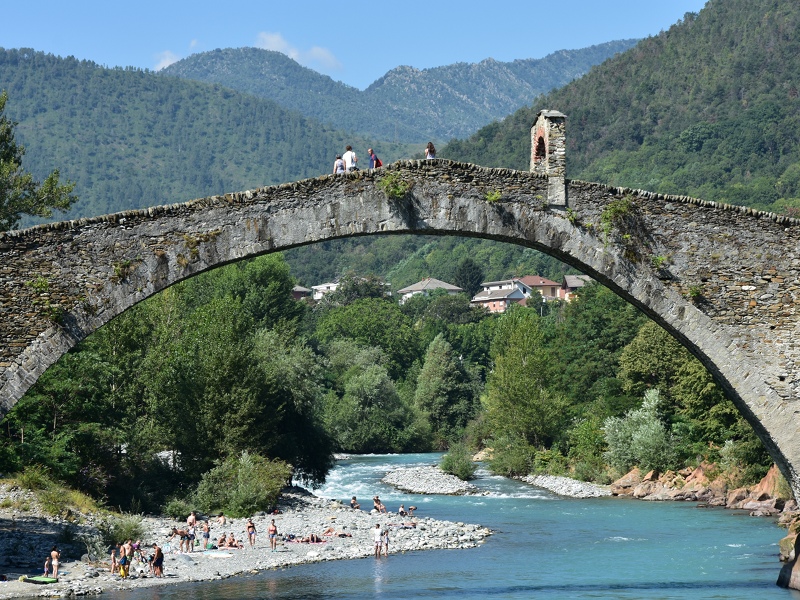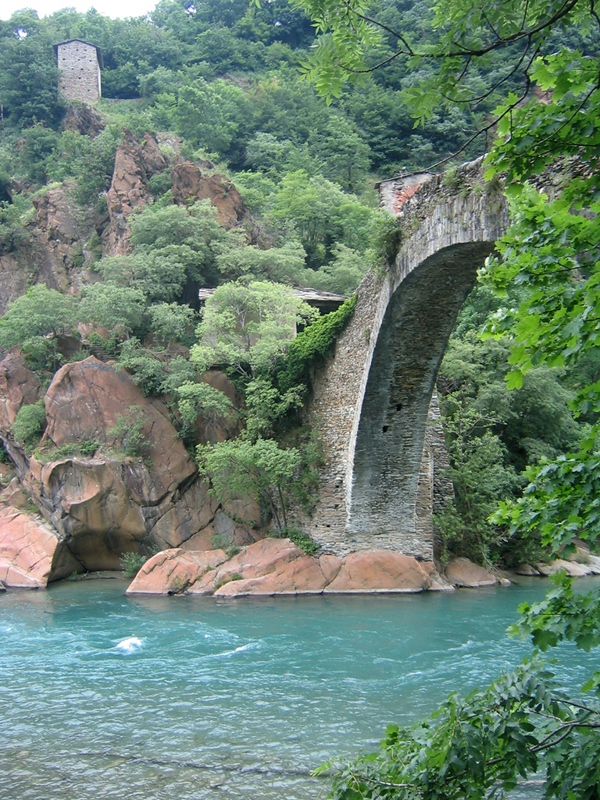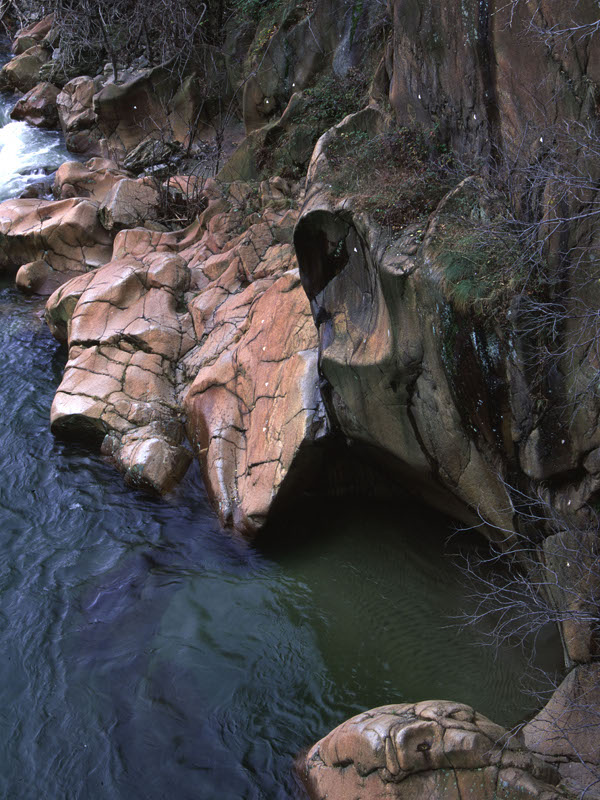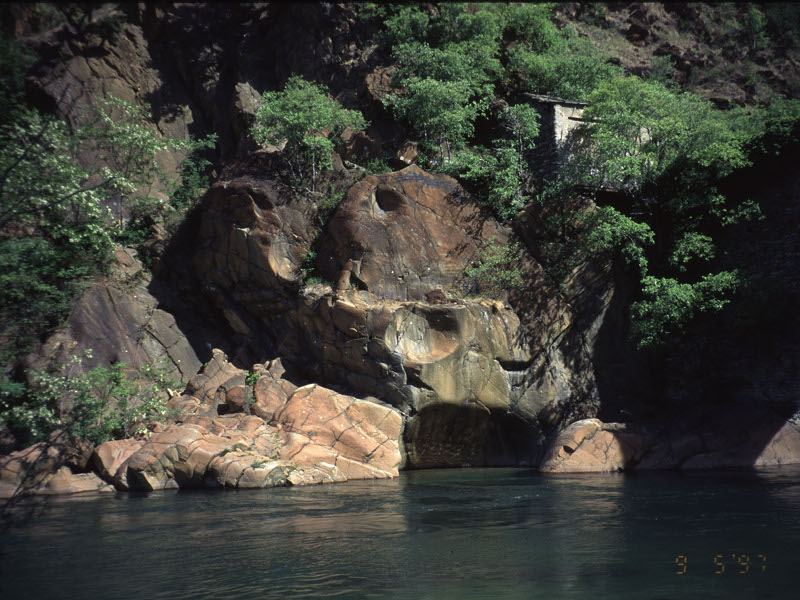Protected Area
Identity Card
- Land Surface Area: 30.55 ha
- Regions: Piemonte
- Provinces: Torino
- Municipalities: Lanzo Torinese
- Establishment Measures: LR 27 14/06/1993
- PA Official List: EUAP0455
- Park Authority: Ente di gestione delle aree protette dei Parchi Reali
Ponte del Diavolo Recreational Area
Ponte del Diavolo Recreational Area, covering a surface area of about 30 ha, has been included in the system of the Regional Parks with the law of Regione Piemonte no. 27 of 14th June 1993 which, together with the Stura di Lanzo Safeguard Area, makes it part of La Mandria Regional Park, already established in 1978, for the following aims:
- a) safeguarding the natural, landscape, and historical features of the area also through measures of environmental recovery
- b) preserving the cultural and architectural features present in the area, guaranteeing their recovery and enhancement
- c) safeguarding the geological features, with particular reference to the formations called "giant's kettles"
- d) organizing the territory with recreational, didactic, and cultural purposes.
These functions of safeguard and enhancement have been entrusted to La Mandria Regional Park Authority and to the Park Authority of Valli di Lanzo Nature Reserves, whose Board of Directors is integrated with a representative of the Municipality of Lanzo Torinese.
The establishment of a Park in the area surrounding Ponte del Diavolo di Lanzo was an intuition by Prof. Augusto Cavallari Murat. Regions with ordinary statute had not yet been established (they will form in 1970) and therefore the Park was born as "municipal park", as a secondary network of the tourist itineraries in the alpine valleys, in a moment in which popular tourism was continuously developing. For this reason, the stone plaques places at the three entrances say: "Parco Comunale Ponte del Diavolo" (Municipal Park Ponte del Diavolo).
The "Committee for the celebrations of the 6th Centenary of Ponte del Diavolo and the Promotion of the Park" was created in Lanzo in 1977. Since its creation, this committee promoted the establishment of the Park. The harsh and steep slopes of Monte Basso and Buriasco, broken and dug during ancient geological periods by the rush of torrent Stura, offer, a few kilometers from Turin, a fragment of alpine landscape where nature and human action have created, in a limited space, an environment of great landscape, scientific, architectural, and historical value and charm, to the extent that also imagination has created romantic or witty legends.
Torrent Stura has a rain-glacial torrential regime. It crosses the valleys for a length of about 62 km and flows into the river Po, in Turin, immediately after the Regio Parco.
In the stretch connecting this area with La Mandria Park, this protected area has been established as Safeguard Area in order to improve the hydrological and biological conditions of the territory and to protect it from polluting agents.
The Devil's Bridge (Ponte del Diavolo)
The main feature of the Park is represented by the medieval Bridge of the Roch or Devil's Bridge ("Ponte del Diavolo").
On 1st June 1378, the Credenza of Lanzo, gathered in the church of S. Onofrio in S. Pietro square and chaired by the lord of the castle Aresmino Provana, decided to create this bridge and to impose for ten years a toll on wine. The expense amounted to 1,400 florins.
The bridge connects Mt. Basso with Mt. Buriasco, in a narrow gorge with overhanging walls, dug in prehistoric times by torrent Stura, which formed a large lake in the plateau of Germagnano.
The bridge, of great architectural and historical value, of about 37 meters of range, is formed by one only Gothic arch, 65m long, 2.17m wide, and 15m high. It is a humpback bridge whose 37m range still amazes.
Popular imagination indulged itself in creating legends around the bold building, to the extent that it was ascribed to the devil: among the others, Angelo Brofferio, Giovanni Prati, and Nino Costa.
There's also who can recognize, at the beginning of the bridge at S. Rocco chapel, the footprint left by the devil's claw: as a matter of fact, after finishing the job, the devil would have crossed the bridge with one only big step. Or could it be a sign of anger because of the trick by the people of Lanzo who, instead of the soul as agreed, left him in the bag a poor dog or a cheese round?
However, the bridge played a very important role in the history of Lanzo and the Valleys. On 15th July 1564, since there was a great fear for the plague, the Council of Credenza della Castellania decided to build, at the top of the arch, a door to close the Bridge of the Roc and, at the same time, to place guards at the borders of the territory. On 7th September of the same year, no one could access the valleys, except those people showing a document of the place of origin, marked with the seal of Lanzo.
Giant's Kettles (Marmitte dei Giganti)
In very ancient times, Mt. Basso and Mt. Buriasco were united. Behind them, in the basin of Germagnano, there was a large lake collecting the waters from the mountains. They could slowly open a passage in the rampart of rock and earth. The signs of the erosion can be seen in the rocks immediately upstream Ponte del Diavolo, on the left bank, behind S. Rocco Chapel. They are the so-called "giant's kettles", geomorphological phenomena dating back to the Quaternary period. There are 21 of them scattered at different altitudes on 18 meters from the level of torrent Stura. They were studied for the first time in 1882 by Francesco Virgilio from the University of Turin.
The smaller kettles are situated behind the chapel, while the "big kettle" is still partly submerged by the water and undergoes an active process of mechanical erosion given by the whirling movements caused by the narrowing of the gorge and the action of the river pebbles and the sand during the flood periods.
Popular imagination called them "ramine" or pots, since according to the legend they were used by giants or by the devil to cook soup.
Flora
Ponte del Diavolo is set between two opposite slopes: the slope of Mt. Buriasco, facing south, and the slope of Mt. Basso, facing west-north-west.
The different exposure of the two slopes is the cause of some variations in the composition of the flora: probably, the slopes of Mt. Basso are more homogeneous and the slopes of Mt. Buriasco more varied.
The shore of torrent Stura has a rather characteristic bushy vegetation, here and there shrubby – more rarely arboreal – mainly consisting of black locust trees, alder, and willows, with a banal flora formed by brambles and herbs, subject to the frequent floods influencing it and making it particularly poor.
The rocky slopes immediately at the two sides of Ponte del Diavolo are sometimes partly entirely bare because of the steepness and nature of the rocks, sometimes with moss and pioneer rocky plants: ivy, the small fern called wall-rue, the maidenhair spleenwort, the common polypody, and more evident, Potentilla with the beautiful yellow flowers and the bellflower decorating the cliffs with elegant tufts of purplish-blue bells.
Curious the settlement of a bushy plant: the ornamental butterfly bus with elegant ears of purplish flowers, you can find along all the access trails of the Park.
On the cliffs, there is a shrubby-woody vegetation rich in brambles and colonies of heather.
The arboreal essences include ash trees, poplars, birches, nettle trees, hazelnut trees, chestnut trees, willows, as well as shrubs like rowan, buckthorn, and juniper. Among the bushes you can see the elegant French rose both with carmine flowers and – more rare – with white flowers.
At higher altitudes, among the rocks coming down from the ridge of Mt. Basso, in different locations, it is possible to find the Little Gentian and sometimes the bilberry, the cyclamen, and the rare Euphorbia gibelliana, the Platanthera bifolia (an orchid) and the very scented and probably exactly for this reason bound to disappear, Daphne cneorum with its small pink-purple flowers (called "galere").
Then there are some plants still living on the walls of Ponte del Diavolo: they include Hedera helix, especially on the two backs of the bridge, Asplenium trichomanes, Asplenium ruta-muraria, Sedum album, Sedum dasyphyllum, as well as some moss and lichens resisting over the years and despite winter and summer weather, almost "painting" of green, gray, and yellow the stones that are a few centuries old now.
Two particular plants are worth a special mention since, despite the inhospitable environment, they can "live" and "survive" in this biotope: the nettle tree and the birch.
Celtis australis (nettle tree), particularly present on the slope of San Rocco, is a very imposing plant whose roots deeply penetrate among the rocks, often breaking them. It can be recognized for its ash gray bark, rarely with fissures, the lanceolate leaf with an intense green color and slightly hairy in its lower part. The small fruits, round and resembling black dots when they are ripe, are edible and sweet, and they often fall after the leaves.
Another pioneer plant set among the fissures of the steep slopes with the birth, with its thin and while bark, with some cuts. Its branches are thin and floppy, the leaves have a shaded dark green color. The floppy flowers look like a long caterpillar and are called catkins. The specimens often form small groups but they are small, demonstrating the poverty and acidity of the soil housing them. According to the tradition, the branches of the birch were used to build the magic brooms of the witches.
Fauna
The brambles and weeds growing along the trails and on the slopes give shelter to various animals: hares, foxes, beech martens, badgers, and maybe also to some pheasants! Also the squirrels, above all during the evening, come down from the woodlands to visit the Bridge!
Climbing along the slopes of the two mountains, it is possible to sight wild boars, red deer, and also a few chamois, animals we find increasingly closer to the houses, also because of the climatic changes.
The uphill trail leading to San Giacinto is controlled by green lizards which, motionless, wait for the visitors to get closer and then run away after the first glance. Besides the common lizards, there are many snakes (grass snakes and vipers): don't worry, it is enough to make some noise to keep them far from you.
The sky is dominated by the gray heron, with its slender shape and slow flight, watching over the area leaving from the nests situated in the pinewood of Mt. Buriasco. It can be recognized for its big size and the gray color of its upper parts. It can reach the 90cm of length. The long beak is yellowish. Like all herons, it flies with its neck embedded in the shoulders, while the paws are stretched backwards.
If you look under the bridge, you will see the rich fish fauna of torrent Stura, a regulated fishing area, where it is possible to find graylings, marble trout, and brown trout.
Prohibitions in Ponte del Diavolo Area
In the whole territory of Ponte del Diavolo Recreational Area, besides respecting the State and regional laws as far as the safeguard of the environment, flora, and wildlife is concerned, as well as the laws on hunting and fishing, it is not allowed to:
- a) open and keep quarries of any kind
- b) open new damping grounds
- c) damage structures of the existing historical and architectural features and geological formations
- d) practice hunting: however, the activities established by the regional law 8th June 1989, no. 36 are allowed
- e) alter and modify the natural conditions of the life of the animals
- f) damage or destroy vegetables of any species and kind, except for the normal forest activities
- g) cut or damage the trees that have particular environmental or scientific value, defined and established by the Plan in art. 10
- h) practice recreational and sports activities with off-road vehicles
- i) build new roads and enlarge the existing ones
- l) build new structures, permanent or temporary
- m) light fires at a distance of no more than 100m from the woodland (LR- 32/82)












